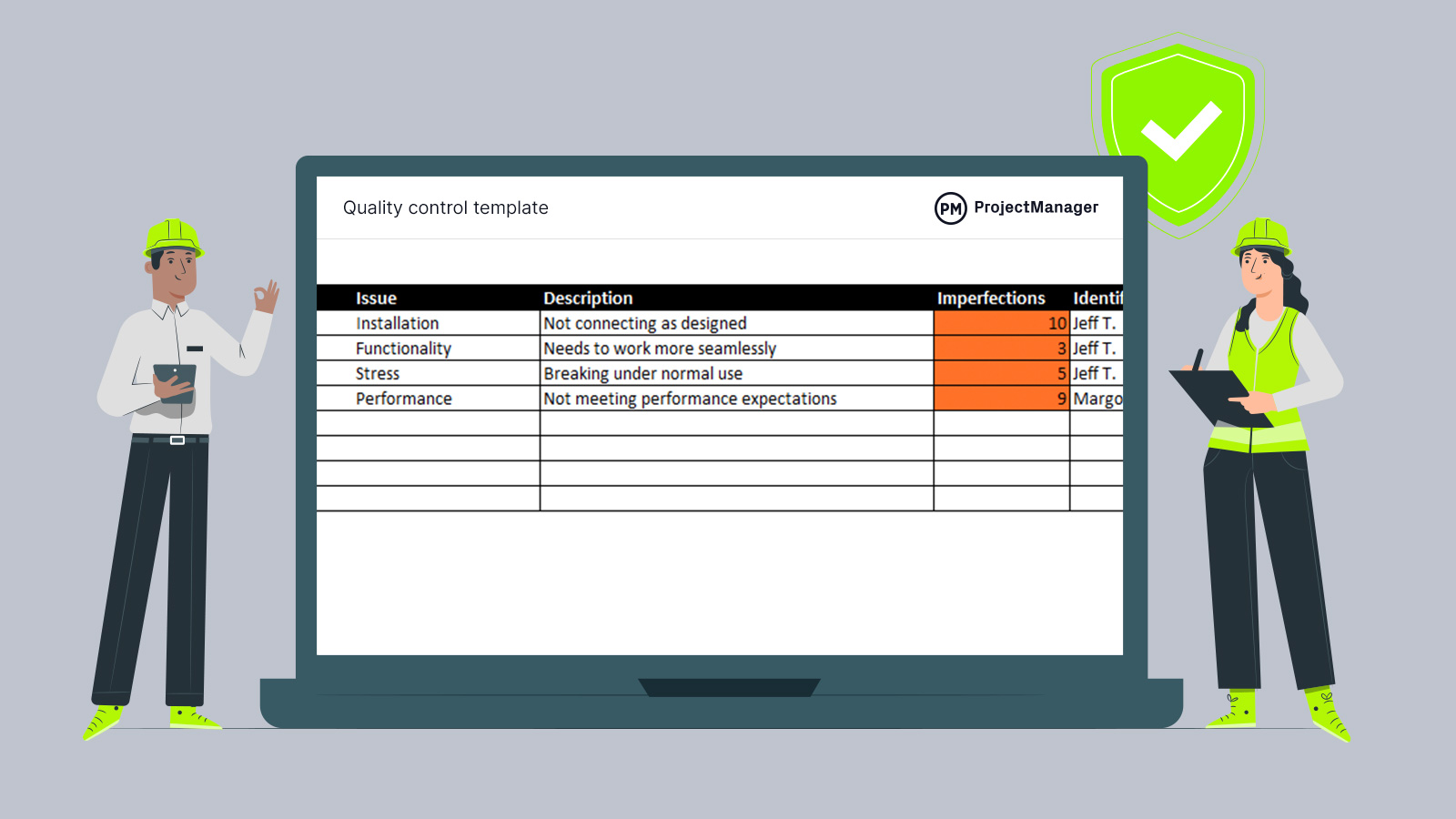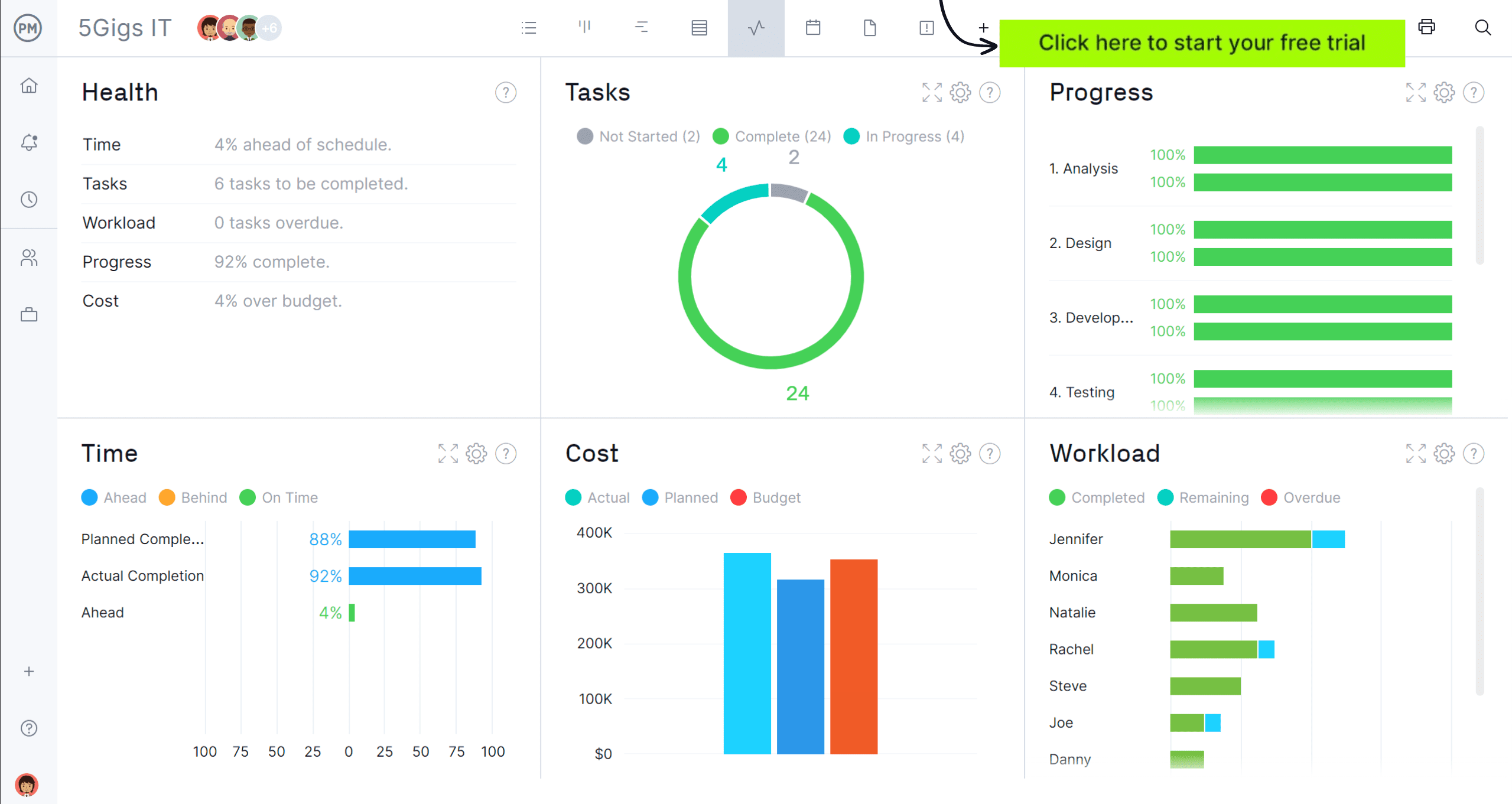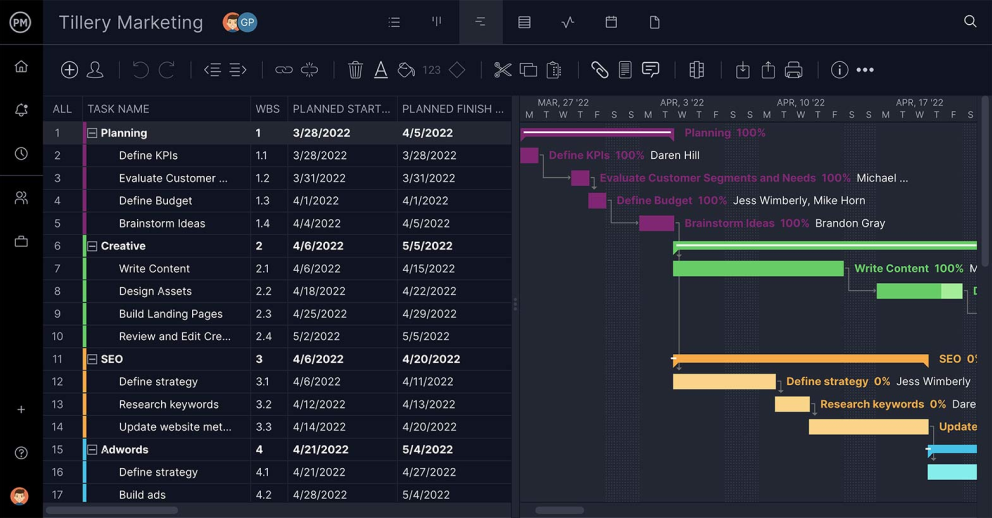When you’re managing a project, the triple constraint should always be top of mind. But there’s a fourth constraint that’s just as important, yet sometimes forgotten by some project managers as they go through the project planning phase—project quality management.
What Is Project Quality Management?
Project quality management is the process of defining quality standards for the deliverables of a project, as well as the quality assurance measures to guarantee those standards are met. However, quality can be an elusive word.
In project management, quality is simply what the customer or stakeholder needs from the project deliverables. Project quality management can be simply defined as the combination of quality planning, quality assurance and quality control activities. Project managers further define these for their projects through a quality management plan.

Get your free
Quality Control Template
Use this free Quality Control Template for Excel to manage your projects better.
Who Is Responsible for Project Quality Management?
The project manager has the overall responsibility of planning, implementing and monitoring project quality. They ensure that the project meets the defined quality standards. However, other roles may be involved.
Project team members, for example, are responsible for the quality of their individual tasks and deliverables. They also need to adhere to the established quality standards. Quality managers, such as quality assurance personnel, may be involved in some projects as they help develop quality plans, conduct audits and ensure compliance.
Stakeholders may also play a role as they define quality requirements and expectations. They provide feedback to ensure the project meets their needs.
Key Elements of Project Quality Management
Project managers oversee the implementation of a project quality management plan. The main idea, again, is to deliver a product or service to the specifications of the customer or stakeholder. Doing so requires knowing quality management concepts.
Customer Satisfaction
Without customer satisfaction, there can be no quality. Even if a deliverable meets all aspects of what the customer or stakeholder has required but is done so where the process itself wasn’t satisfactory, there’s a problem.
Of course, the deliverable must meet those requirements, or else the project has failed because the product of the project and the management of the project didn’t meet the expectations of the customer or stakeholder.
That’s why implementing quality control means managing both processes and people. Meet with your customer or stakeholder regularly to keep them abreast of the project’s progress. Get their feedback and make sure that you’re fully transparent to avoid issues arising later.
Prevention Over Inspection
Quality doesn’t come for free. The cost of quality (COQ) is the money spent dealing with issues during the project, and then after the project, to fix any failures. These are broken up into two categories: cost of conformance and cost of non-conformance.
The cost of conformance can be considered a preventive cost. These project costs are primarily related to training, the documentation process, the equipment needed, and the time required to get the quality done right. Other costs related to this can include testing, destructive testing loss and inspections.
The cost of nonconformance refers to internal failure costs. These consist of reworking something or even scrapping it entirely. Further costs can come from liabilities, warranty work and lost business.
Continuous Improvement
Continuous improvement is a technique that allows project teams and project-based organizations to improve how they work over time through small incremental changes, which helps deliver high quality project deliverables.
Applying this concept also means constantly monitoring any issues that come up, so you can then use the lessons learned when managing future projects. This way, you run a more efficient project and likely won’t repeat mistakes.
To monitor project quality, you’ll need the right project management software. ProjectManager offers the best project planning, scheduling and tracking tools for effective project quality management. Use Gantt charts, kanban boards, project calendars and other tools to keep track of project tasks, resources, project deliverables in real time. Get started for free.

Examples of Project Quality Management
Project quality management applies to nearly any project in any industry. Below are some examples to bring this concept to life.
- Construction Project Quality Management: Infrastructure projects in construction focus on structural integrity and safety, which is accomplished through adherence to building codes and standards. Regular inspections and testing are also helpful in ensuring compliance with specifications.
- Manufacturing Project Quality Management: In manufacturing projects such as electronics manufacturing, there is strict quality control to ensure the electrical components are reliable and perform as they should. Automotive manufacturing projects revolve around minimizing production defects through lean manufacturing and Six Sigma methodologies.
- Professional Services Project Quality Management: A professional services consulting firm may focus on service-level agreements (SLAs) with clients as they outline deliverables, timelines and expected outcomes. They may also conduct regular training sessions with consultants to maintain and enhance their skills.
- IT Project Quality Management: Project quality management in IT projects focuses on service quality and customer satisfaction. For example, teams often use quality management systems to monitor and improve IT service delivery. There is also a focus on adhering to service-level agreements.
Quality Control Template
This free quality control template for Excel is ideal for logging any issues found while inspecting the quality of your products or project deliverables no matter what industry you’re in. It allows you to track key aspects of the quality control issue, such as the date when the issue was found, who identified the quality control issue, who’s responsible for fixing it, and priority and status levels.

What Is a Quality Management Plan?
A quality management plan is a document that helps project management teams establish quality planning, quality control and quality assurance procedures to maintain quality standards throughout the execution and completion of a project.
Now, let’s define the components of project quality management in more detail.
Quality Planning
First, identify the quality requirements for your project deliverables and how the project needs to be managed. Agree on how this process will be documented and how that information will be delivered. Will you have regular meetings, emails, etc.?
The quality planning section will include these specifics as well as metrics for measuring the quality while managing the project. This should include a quality checklist to collect and organize the marks you need to hit during the project.
Quality Control
Quality control is the first step in project quality management. It consists of determining quality requirements for project deliverables and testing, inspecting and reporting to make sure they’re met.
While it’s similar to quality assurance (QA), the main difference between them is that quality assurance (QA) focuses on improving processes to maintain quality standards and prevent issues, while quality control (QC) focuses on inspecting and identifying issues.
The main role of quality control is to ensure rules are being followed and that the expected project quality standards are met. Some ways to ensure that the required quality of the deliverables is being achieved is through peer reviews and testing.
Quality Assurance
Quality assurance is the planned and systemic activities implemented in a quality system so that quality requirements for a product or service will be fulfilled.
Use quality assurance to ensure your processes are in fact working towards making the project deliverables meet quality requirements. Two ways to accomplish this are by using a process checklist and a project audit.
Traditional Project Quality Management Tools
These project management charts are commonly used for project quality management.
- Project network diagrams: Project network diagrams allow project managers to map out project tasks and deliverables. This helps understand the activities required for each project deliverable, which greatly helps ensure quality at each step.
- Affinity diagrams: Affinity diagrams help project teams group ideas, information and data about project deliverables and products. This helps teams better understand the different quality requirements they need to look out for.
- Matrix diagrams: There are different matrix diagrams that can be used to establish relationships between deliverables and quality standards. They’re a great way to organize project quality management information.
- Process decision program charts: These charts are used to identify what could go wrong in a plan. In project quality management, they help project teams avoid problems and create countermeasures if quality assurance procedures were to fail.
- Interrelationship diagrams: Interrelationship diagrams allow project quality management teams to understand the different cause-and-effect relations between factors that affect the quality of project deliverables.
While these charts are a good alternative to managing project quality, using a project management software like ProjectManager is a much better alternative for project managers and team members.
ProjectManager offers dynamic tools such as Gantt charts, kanban boards, task lists and much more so project teams can stay on top of quality planning, assurance and control. On top of that, ProjectManager is fully online, so you can collaborate with team members anywhere, anytime.
Using ProjectManager to Manage Quality
Managing the process of project quality involves many things, such as setting quality targets for your team to meet, defining how to measure those quality targets and reporting on them. Project management tools like ProjectManager can prove helpful with this.
ProjectManager has online Gantt charts that make scheduling and monitoring tasks related to quality management simple. With ProjectManager, you can upload a task list or spreadsheet, which is then instantly populated on a timeline.

Our online Gantt charts also provide a great collaborative platform for your team. Each task is usually able to link to supporting documents, images and other files, as well as offer a dialogue where team members can talk about the task and resolve any issues that arise.
Related Content
- Total Quality Management (TQM): A Quick Guide
- How to Handle Time, Cost & Quality in Project Management
- Construction Quality Control: Essential Tips for Managing Quality
- Meeting Quality Targets on Projects
- Tips for Quality Testing
- Quality Control in Manufacturing: A Quick Guide
Quality is important in any project, and to ensure quality, the right tools are needed to monitor quality management. ProjectManager is online software with a real-time dashboard and an online Gantt chart that makes monitoring and reporting on quality easy. See for yourself by taking this free 30-day trial.

